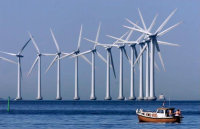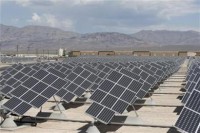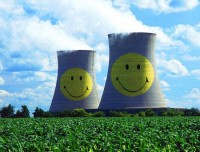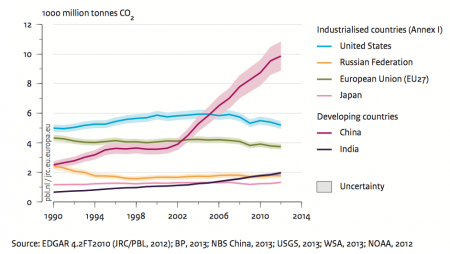Global warming or not, coal and oil are not the best energy sources. Especially coal emits a lot of radioactive fumes and soot that is not nice to have in cities. Both coal and oil are limited quantities we will inevitably run out of. Not as soon as people who totally do not have a vested interest in competing energy sources, but eventually.
 Wouldn’t it be great if we could use something ubiquitously available like the weather: sun or wind? Well, good news, we can! Then why don’t we?
Wouldn’t it be great if we could use something ubiquitously available like the weather: sun or wind? Well, good news, we can! Then why don’t we?
Well, there are a couple reasons. Current sustainable energy sources in the form of solar and wind are quite bad, to the point they need substantial government support. Furthermore, the current generation is not really renewable either, and we have other options with a bigger positive impact on the environment.
Wind Power
Denmark is the country in the world with the largest percentage of wind energy. The largest windmill producer (Vestas) is Danish, and there are a couple other companies with a huge interest in Denmark. This makes sense – Denmark has a reasonably stable power grid that is well-connected, and also Denmark is basically a big peninsula with a couple surrounding islands, ensuring there is a shitload of wind.
Then, how much of Danish energy comes from wind energy? Well, the number typically advertised is that over 30% of the energy comes from wind. Isn’t that great? It proves that wind is a realistic alternative to fossil fuels; it’s only off by a factor of roughly 3.
The problem is that this is a big fat lie. Denmark gets around 30% of its electricity from wind. Virtually all other energy comes from our old friends, coal and oil/gas. According to the US Energy Information Administration, Denmark uses approximately 32.620 million kWh of electricity in a year (and produces slightly less). The total energy consumption, on the other hand, is 223.000 million kWh of energy ((0.761 quadrillion BTU.)). Multiplying this, we get that only 30% • 32.620 / 223.000 = 4.4% of the total Danish energy comes from wind. Other sustainable energy sources are negligible. Still quite good, but a long shot from the 30% cited. And this is the world leader. The world leader gets less than one twentieth of the energy from wind power. In comparison, Denmark gets around 22% of the energy from coal.
People tend to think that wind energy is “free” and safe. It is not really either. To produce power, windmills need permanent magnets, which are not exactly rare, but also not that common. Windmills are also typically produced using liberal amounts of aluminum, which is ridiculously expensive to refine energy-wise. In fact, a modern windmill only makes the energy put into producing it back 80 times over a lifetime. As for safety, take a look at this cool video of a windmill running amok:
Sure, this only happens around once a year or so, but it would still suck to live underneath it. Not just for the risk of an accident, but also because they make low-frequent noise disturbing anybody living near them. Of course, these problems can be alleviated by moving mills off-shore, but that it not really economically viable as of yet.
In fact, windmills are a shitty business plan; so much so that governments have to subsidize windmills. Denmark actually has not only the highest percentage of energy coming from wind, but also the world’s highest electricity prices. Not to mention the curious fact that when the windmills produce at their peak, Denmark has to pay to get rid of the power to Germany and Sweden, whereas when there is no wind, Denmark has to pay to get power from Germany (coming to a large part from coal) and Sweden (which is mostly actual clean sustainable energy).
Add to that, that the world as a whole gets around 2.5% of the electricity from windmills, which means that around 0.51% of the world’s energy comes from wind. Does it sound plausible to rely solely on wind?
 So, in conclusion, wind is unreliable (only works when the wind blows), expensive, if not outright dangerous then at least a constant nuisance for people living near it, and not really that sustainable.
So, in conclusion, wind is unreliable (only works when the wind blows), expensive, if not outright dangerous then at least a constant nuisance for people living near it, and not really that sustainable.
Solar Power
Solar power must be good then, right? At least in deserts and other sunny places. Solar is even less common than wind (around 0.41% of world-wide electricity comes from solar, for a whopping 0.06% of total energy – more if we include other ways of using solar that is not solar cells). Solar is not really inherently dangerous, and may even be good environmentally for deserts (they remove heat). The big problem is that solar using current technology is very far from sustainable. Solar panels require polysilicon, which is hard to make, or cadmium telluride, the emerging baby brother, whose first component is extremely poisonous and whose second component is severely limited.
Solar shares the problem with wind that it only works under the right weather conditions. This requires storing the energy. This can be done in batteries (which require more rare metals), by pumping water (or another liquid) to a high place, by spinning a wheel, compressing air, or other reversible processes where we can get energy from the exothermic reaction. Common for all of these is, they lose energy on the way, making the energy sources even less efficient overall.
Electric cars can to some extent alleviate this; they can be charged “anytime” as long as they are ready for the day after, and in principle the battery can be discharged during night if needed and recharged in the morning, using the electric car batteries as a power storage. Of course, this technology is not deployed.
All in all, solar is just not ready for wide deployment unless supported by something else which is easy to turn up and down.
Hydroelectric Power
Here’s a sustainable energy source that is actually working. Hydroelectric power is all about slapping up a dam and have water run thru a turbine. It is responsible for 16% of electricity use worldwide (or 3.3% of total energy). It of course sucks building a huge dam and when it breaks down, but at least it can produce a lot of relatively clean energy.
Of course, hydroelectric plants only works when you have (or build) a height difference and a lot of water, so it is not really an unlimited power source, even though it is mostly sustainable.
Other Renewables
The biggest source of “renewable” energy is biomass, which is responsible for around 11.4% of total energy. The problem is that biomass is a bunch of bullshit. The idea is to grow food and instead of feeding it to hungry people, burn it. Alternatively, chop down some trees and burn them. The idea is that the amount of CO2 consumed by plants offsets the amount of CO2 produced when burned.
 On the surface this is great, and does reduce CO2 emissions, but the use is fairly controversial, mostly because it does make smog pollution, the rate of which the CO2 is consumed by new plants is very low, the renewal of several of the plants is slow (e.g., trees), and there is a discussion whether land areas should be used for producing biomass or food, with the hungry typically yammering on about the latter being more important.
On the surface this is great, and does reduce CO2 emissions, but the use is fairly controversial, mostly because it does make smog pollution, the rate of which the CO2 is consumed by new plants is very low, the renewal of several of the plants is slow (e.g., trees), and there is a discussion whether land areas should be used for producing biomass or food, with the hungry typically yammering on about the latter being more important.
By the way, the 7th largest renewable energy in the Netherlands is heat recovery from fresh milk. It is responsible for 0.3% of the renewable energy produced in the Netherlands in 2011.
The Lack of Perspective
If we add the most dominant “sustainable” energy sources together, we get that around 5% of the world’s energy consumption comes from sustainable sources despite huge costs and years of development. Further adding biomass, we get to around 16.7%. We’d need at least 20 times as much renewable energy as we have now, and that’s being generous, because most of the renewable sources are quite unreliable and needs an energy storage, which eats away some of the produced energy. If we allow calling burning food and forests sustainable, we’d “only” need 6 times as much as we have now.
Does Sustainable Energy Automatically Reduce CO2 Emissions?
Let’s compare 4 European countries and their CO2 emissions. Denmark is very big in wind, Germany is very big in solar, and Norway is very big in hydroelectrics. On the other France, is a dirty, dirty country which uses nuclear power. The CO2 emissions per capita for 2008 are:
| Country | Emissions/capita/tons (2008) |
|---|---|
| Denmark | 8.4 |
| Germany | 9.6 |
| Norway | 9.4 |
| France | 6.1 |
So, France beats all despite Denmark being world-leader in wind, Germany in solar, and Norway in hydroelectrics. The three world-leaders in sustainable energy emits more CO2 per capita than a country that relies mostly on non-sustainable energy (well, nuclear is actually sustainable, but let’s get back to that).
 There are a couple reasonable objections to the above; I’m using rather old numbers but they are the newest ones I could find. Wind has grown in Denmark and solar has grown immensely in both Germany and Denmark in terms of installed capacity since 2008. On the other hand, Germany decided to switch off a large number of nuclear reactors after Fukushima, leading to vastly increased use of oil and – especially – coal.
There are a couple reasonable objections to the above; I’m using rather old numbers but they are the newest ones I could find. Wind has grown in Denmark and solar has grown immensely in both Germany and Denmark in terms of installed capacity since 2008. On the other hand, Germany decided to switch off a large number of nuclear reactors after Fukushima, leading to vastly increased use of oil and – especially – coal.
Another reasonable objection is that I may have cherry-picked the numbers. At least, France is much further to the south and needs less energy for heating. That is to some extent true, but France really is one of the industrialized countries with the lowest emissions. Spain and Italy emit much more (7.5 and 7.4) whereas Portugal (which is hardly as industrialized) emits less (5.3). The average for the EU is 8.1, and a curious exception is Sweden at 5.3. Sweden by the way has both nuclear and hydroelectric.
Good Is the Enemy of Perfect
This is where the lack of perspective comes in. It is of course not sensible to compare countries like that except for anecdotical evidence that sustainable energy may not be the end-all to energy problems. The real kicker is that maybe we shouldn’t solely focus on getting the cleanest sustainable energy. Maybe it’s better to focus on getting away from the most dirty sources.
We already mostly abandoned peat as a source of energy. Peat is basically mud or cow-dung that is burned for energy. Unsurprisingly, the burning isn’t particularly clean and it emits a lot of smoke for meager energy gains. Coal is much better, but still way behind in class compared to sources like oil and gas. Sure, they are not sustainable, but they are here now and they work. For example, coal is responsible for around 27% of energy used, yet responsible for more than 41% (41% of total fossil emissions) of CO2 emissions. Coal emits more than twice the CO2 of natural gas (and even less of other greenhouse gasses), with oil sitting in-between. By shifting all coal use to natural gas use, we’d remove more than 20% of CO2 emissions, which is at the level of the strictest requirement of the Kyoto accord (ignoring Luxembourg), which – by the way – was only met by former Soviet countries and Germany.
Around 2000, the US started production and switching petroleum and coal to shale gas. It burns much cleaner and is a large part of why the US has reduced emissions more than the EU since 2000:
In numbers, the EU27 reduced emissions from 2000 to 2012 from 4.06 billion tons to 3.74 (reduction of 7.9%) whereas the US reduced from 5.87 billion tons to 5.19 (reduction of 11.6%). In the same period, the US increased power production and lowered prices, whereas the EU reduced production and increased prices. Most of the reduction (both in EU and US) has happened since 2008.
The effect of switching energy sources that pollute the most is much larger than switching to entirely neutral sources. Also of interest is that China is really on the rise since 2002, and they primarily use coal.
Sure, shale gas (“fracking”) has its downsides. But so does coal (polluting as hell), oil (scarce), biomass (taking land from food), wind/solar (unrealistic), hydro (limited).
We have to remember that “good is the enemy of perfect” works both ways, and if we strive for perfect but unobtainable or hard-to-obtain energy sources, we may not get the immediate gains we can get. We have to make sure we don’t replace one depletable energy source (oil and gas) by another (solar and wind depending on rare earth metals or hydroelectric with very specific geographic requirements). Maybe replacing one very polluting energy source with a better less-polluting energy source (which is still not sustainable nor non-polluting) is better than replacing a tiny fraction of the original source by a perfect source.
If the goal is really to reduce pollution rather than political, getting a small gain on a large percentage of the energy production might be better than getting a twice as large gain on a tiny fraction of the production. This is the deal we get from shale gas vs a switch to a barely working renewable source. And shale gas, while still a limited resource, will last for the foreseeable future while we make the renewables actually work.
Nuclear Energy
 It’s not really possible to discuss energy and leave out nuclear. Nuclear has a bad name because of a couple tragic accidents and because it is similar to the technology used for making big bombs.
It’s not really possible to discuss energy and leave out nuclear. Nuclear has a bad name because of a couple tragic accidents and because it is similar to the technology used for making big bombs.
All of the three major nuclear disasters, Three-Mile Island, Chernobyl, and Fukushima happened to generation 2 reactors (Chernobyl also had generation 1 reactors, but the meltdown happened in reactor 4, which was gen 2). The current generation 3 is much safer, and if we try and not build them in earthquake epicenters nor under failing totalitarian regimes, chances are that the number of accidents happening to gen 3 reactors is at most going to ever double, i.e., stay at a safe 0 accidents forever.
Add to that that one of the big competitors of nuclear, coal, is actually more radioactive, so not only do nuclear plants produce less CO2 (none), less smog and soot, they also produce less radioactive pollution.
And radioactive waste is not waste. It is new fuel for reactors. It is not commercially viable yet, but within 15-20 years, the first generation 4 plants will be built, safer and real sustainable.
Conclusion
At the end of the day, we need energy. Sustainable energy as we know it isn’t really, and only amounts to around 5% of total energy consumption, not almost a third as is often advertised. Not only do we need it in the Western world, but it is also needed in the developing parts of the world, where people live on a lower Maslow level and hence don’t care where energy comes from. Which most likely means coal.
Improvement is important not only for global climate, but also for local; many big cities suffer from air pollution from cars and power plants. Power plants can be moved away (and replaced by a cleaner version), and cars can be made electric. That does not make the cars pollute any less (especially if powered by coal-generated electricity), but moves the pollution away.
We of course need to work on future generations of especially solar, which is a technology with a lot of potential. For the shorter term, we probably need to be more pragmatical, though. Shale gas is a good replacement for coal and even oil; nuclear is much better.
On the longer term, we probably need nuclear with solar playing a role in urban areas and off-shore windmills in areas where they make sense. Hydroelectric is useful, and by far one of the more useful renewables right now, but probably not possible to expand significantly in the future due to the limited locations it makes sense. Biomass is probably going away as the Earth population rises.



Solar FREAKIN’ Roadways!…. Well i actually prefer nuclear power but the tron style led’s in the roads is worth any price….
https://www.youtube.com/watch?v=qlTA3rnpgzU
tl;dr , fyi Vestas (used to?) use Dutch parts, such as the column which is mostly made of steel. and: ‘tend to thing’ :). The mill that explodes in your movie appears to be made from fiberglass. lastly: modern windmills can shutdown or rotate during stormy weather which minimizes potential damage 🙂
Remember that green tech creates jobs. If we hurry up getting effective gen IV nuclear plants and people warm up to them, the problem with CO2 is almost solved, whereas most other green techs all work to reduce CO2 pollution instead of eliminating it. Thus, once gen IV is the way to go, politicians can no longer create jobs to reduce CO2.
Since we shouldn’t place nuclear plants in areas with significant seismic activity (then it’s safe), how should Japan out of all options generate electricity?
Obvious (though not necessarily cheaper) solution: Buy it from abroad. Engage in trade agreements that involve collaboration on the building and running of nuclear plants abroad, in order to keep the cost down.
@Jens: roads are a good place for solar panels – don’t solve the fundamental problem of solar, though: they still depend on a limited resource. Funny aside, a couple months ago there was an experiment with something similar in the Netherlands (believe it was in Appeldoorn, but I may be wrong). Filed a couple weeks ago because the tech couldn’t work in rain, which we have a lot of.
@Stefan: most of huge towers are a mixture of materials; concrete and steel are parts (I believe the wires are steel). Most modern mills SHOULD shut down with too much wind (actually, they are making experiments to make them actually work in windy conditions), but this sometimes fails. The depicted mill did use older tech, but new mills can fail in the same way. The wings are still made from fiber glass and aluminum.
@Brian: that’s very true, qua my comment on whether we’re doing things for environmental or political reasons. Still need to remember that gen IV is still some 20 years away, though III and III+ are here now and way better than the spolody plants of yore.
@Dirk & CNN: yup, the idea is to make energy more global. Fukushima could MOST LIKELY have been avoided with a gen III plant (it failed in part due to all generators for the cooling failing, gen III improves over II a.o., with passive cooling which would likely have saved the plant). Environment is a global issue, and there’s no reason the solution can’t be. It of course doesn’t really help that Japan hates all it’s neighbors. There’s already a lot of international cooperation in nuclear; e.g., storage. For a more fun international cooperation, the US is currently the biggest buyer of old Russian nuclear warheads. They are used as fuel in nuclear reactors in the US. Nuclear power actually helps reducing the nuclear threat.
Another fun fact if saw while researching this piece: we have plenty (known and economically feasible) coal for the next 150 years. This means we can totally fuck up the environment before running out of coal. Coal is basically a sustainable (but not clean) energy source. Which is why it is so cheap and why we need to focus on getting rid of coal now in a sensible (and cheap) way instead of dreaming of technologies that won’t work for another decade or five.
Michael Westergaard: Have you factored in the cost/CO2 emissions/other sustainability issues of mining and refining nuclear reactor fuel?
I have not. In part because it’s inherently difficult to find numbers. The closest I could find was http://www.epa.gov/cleanenergy/energy-and-you/affect/air-emissions.html, which mentions that mining “everything” releases CO2, SO2, N2O and methane. Mining uranium is only mentioned to have transport costs energy-wise.
Especially, the worse gasses, are even more abundant than CO2 for the dirtier energy sources (coal < oil < petroleum < gas < nuclear). According to http://www.climatechangeconnection.org/emissions/CO2_equivalents.htm these matter even more (methane = 25 * CO2, N2O = 298 * CO2 etc), but I avoided them because even though it would further strengthen my position, it would clutter the discussion as people only know about CO2.
Furthermore, as mentioned, a large part of uranium comes from nuclear warheads. According to http://www.world-nuclear.org/info/nuclear-fuel-cycle/uranium-resources/military-warheads-as-a-source-of-nuclear-fuel/ currently 13-19%.
I’m not sure the mining process is especially problematic, but I wouldn’t be surprised if the refinement process is. As I understand it (and I am not at all an expert), the ratio is something like 1kg of reactor grade refined uranium to 100kg of uranium ore, so surely there is some sort of cost involved here. The greenhouse gas contribution may be negligible, but intuitively I expect there to be some use of chemicals or something, and perhaps also polluting by-products. And although it sounds funny to say it, using nuclear warheads is not exactly sustainable either, as we are running very low on those. 🙂
There is obviously some cost involved. And while war-heads are not a sustainable source, if they get us going for the next 15-20 years till the first breeder reactors (gen IV) are up and running, we are good; breeder reactors basically make their own fuel as a side effect of the energy production.
And chances are, manly-man Putin is cooking up some new war-heads we can use as soon as he gets shot anyway 🙂
I know the Putin argument is supposed to be tongue-in-cheek, but it’s hardly valid. Whether we refine nuclear material for warheads and then use it in reactors, or whether we refine it directly for use in reactors, the sustainability issues are the same (assuming that warheads are not useful in and of themselves). You can only really disregard the sustanability cost of existing warheads, because they were indeed created without regard to sustainable energy.
Another thing you don’t go into is the sustainability cost of producing batteries, which is essential for weather-based energy production, even if we use electric cars. Finally, it seems somewhat unreasonable to disregard future technical development in the materials used to build windmills and solar panels, while at the same time factoring in future developments in nuclear energy. I’m not saying your argument doesn’t still hold water, but all of the possibilities should be treated with equal scrutiny.
I actually factor in that windmills and solar will improve. I just say that right now they are more or less useless. Windmills are also bad because they are loud and tend to fail, being largely mechanical.
We do not necessarily need batteries for solar/wind. Spinning wheel and pumping water are very possible alternatives, which is why I didn’t bother too much with the economy of batteries – heck we can almost just abuse current hydro plants if they are sufficiently close that we can send electricity to them (and I think that even happens).
I say that currently, “sustainable” energy sources are not, much like how nuclear isn’t CO2 neutral yet. Current windmills require expensive rare earth metals and aluminum and only give back the energy invested 80 times over an expected lifetime of 20 years. Current solar panels use polysilicium which is the currently limiting factor and the next, already emerging, generation use an alloy that is poisonous and rare as hell. Hydroelectric is limited by geology and probably not expandable very far. Biomass is just and excuse not to actually solve the problem, and I expect it to go down.
What we need is a short-term solution, and rather than base that on something that does not work, I’d base it on shale gas. It works and we can douse it now.
Mid-term I’d go for more nuclear – the current generation is very safe and decently green (better than gas), and we have a clear outlook. For wind, it was supposed to work “real soon now” for the last couple decades. Same with solar, which only recently started producing more energy than it cost to make the panels.
Long term we probably get some solar that works. Let’s use that “everywhere” – there’s no reason not to. Windmills may also actually be viable then. We’ll have neat gen IV reactors which are much better fuel-wise than the current generation. Biomass can finally go away as the bad idea it is, and we’ll still use as much hydroelectric as we can.
Fun follow-up: http://ing.dk/artikel/danmark-maa-importere-el-hver-uge-168709
The gist: Denmark has to import electricity, because due to the reliance on wind, there is no longer sufficient capacity to produce electricity if there’s no wind. This puts Denmark in the league with Poland, Hungary and Albania. Countries, Denmark often likes to compare itself with.
But at least we are better than Elbonia… barely.
Elbonia still has the prospective of mud-power. One day, I tell you. One day…
Something something precious mud should not be wasted on energy production, as this will lead to widespread food shortages. Biofuel all over again.
“Ifølge rapporten udgør importbehovet i landene dog ikke generelt noget problem, idet der er produktionskapacitet til stede i det europæiske el-system og tilstrækkeligt med kabelforbindelser til at fordele strømmen til de lande, der har behov for den, herunder Danmark.” — In other words, all the benefits of nuclear power, without all the dangers (at least not to ourselves). 🙂
…all produced by german brown coal from Ruhr.
OK, so all the benefits of coal power without all the dangers, potayto, potahto. Our windmills are sucking all the energy out of the winds, so the coal dust isn’t blown all the way to Denmark… 🙂
Ah, the SEP field approach to environmentalism 🙂
I don’t know if you’ve read the article that’s currently circulating the interweb about how solar panels are draining all the Sun’s energy, so that we risk the sun dying out within a couple of hundred years. From this, we can also deduce that burning coal and oil will cool down Earth’s molten core, meaning that Earth will become a frozen wasteland within 15-20 years.
Wow, people actually believe that? The closest thing to truth in that is that it has been proposed as a method to counteract global warming (putting up a giant mirror in space). And even that solution is too Bruce Willis for most people to take it seriously. Yes, Bruce Willis is now an adjective.
Very nice post. I was wondering if you ever read this book http://www.withouthotair.com/ ? (It is free and thus the only book I read on the subject). It makes a pretty compelling argument for why the traditional sustainable energy sources (wind, solar …) are not going to solve all our problems that you do not mention in your post.
Essentially the author looks at how much energy is physically possible (disregarding price) to produce from various sources. That means he tries to look at how much energy we could possibly get from wind, solar and so on. The conclusion is that with our current energy consumption there is no way we can rely on only traditional sustainable sources. Essentially it comes down to ratios of kWh pr. square meter, and the fact that there is just not enough land to place all those windmills, solar panels, tidal-energy plants and so on.
I thought this was rather interesting because it suggests that the reason why we can not go completely “sustainable” is not just about price or politics. In fact it is physically impossible (without cutting energy consumption to a level that is unacceptable to most of us).
Of course that book is a few years old, and the calculations are all a little back-of-the-envelope (the author also admits to this), so maybe it’s not really valid. I was just wondering if it was something you thought about.
Thanks!
Will take a look at the book. I sort-of touched on it for hydroelectrics, but didn’t look into the computations for wind/solar/…. I think if we could produce enough solar panels, could make enough off-shore mills, build hydro plants everywhere it makes sense, etc. it should be possible to provide enough energy. As mentioned, we do get around 5% of total energy from sustainable energy (mostly hydro), and I think it’s possible to scale at least an order of magnitude, and possibly two, which should be sufficient.
The main point here, however, is that the percentages are wildly inflated (if we’re at 30% wind, going to 100% seems feasible, when we know we’re only at less than 5% less so; much less so when the world is at < 1%). This supplements the fact that the energy we can produce is limited in a nice way to strengthen both arguments. That, of course, and the fact that more pragmatical ways may be better on the shorter term. For a much more elaborate explanation of this (I only focus on newer tech like shale gas), check Bjørn Lomborg's Cool It! I've only read the book (which has ample references), but I guess the movie also gives the gist. Current solar tech uses 10-25% of the energy of the sun (10% being the old polysilicon cells, 25% being the new CdTe cells that are in severely limited supply, with the ridiculously difficult to manufacture monosilicon cells in-between). Wind turbines can theoretically convert around 59% of the wind energy, with current commercial mills delivering approximately 75% of that, and yielding around 25% of the max capacity on average, for a 11% overall efficiency (though this number is manipulative; it's not 11% of the wind energy, but the average throughput is 11% of 4 times the average wind, but the number 4 can be lowered and the 75% can be raised leading to better yields). Hydro is around 90%. So, solar can be improved quite a bit, wind a bit and hydro is at its peak.
I think it is a really nice book actually. At least it made me think of things in a very different way.
Do you have any other book/reading material suggestions on the subject?
I like Bjørn Lomborg, but be aware he actually bases his books on current research, which means his older books can come off as “climate-denierish” [1] (terrible term, even before I adjectified it). I highly recommend following him on FB – he often points towards interesting stuff that doesn’t come up in traditional media (e.g., I got much of my information about shale gas from links he posted). Even Cool It!, while a nice book, shows its age already.
[1] They’re not, they’re just pointing out that there is (i.e., was) no conclusive evidence that global warming is human-caused, so purely looking into changing human behavior might not be the best cause of actions; he’s lately changed to global warming is most likely human-caused, so we need to figure out how to offset (not avoid) it the best.